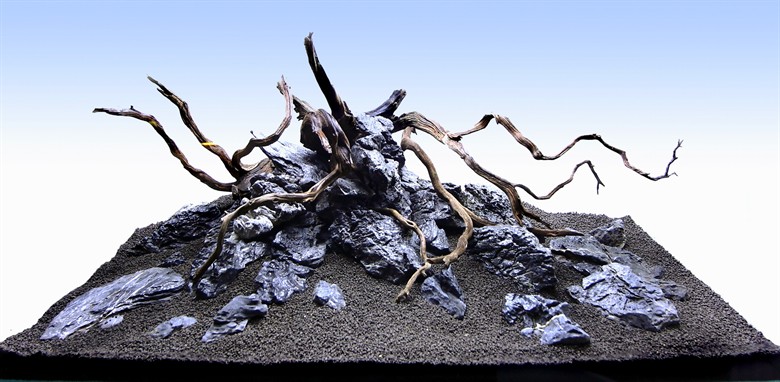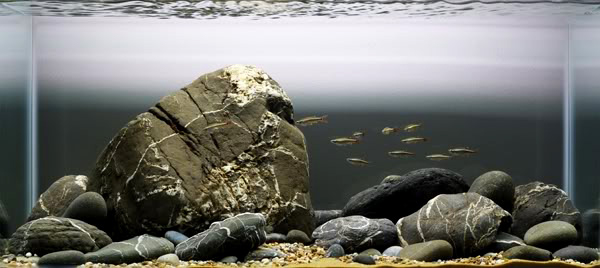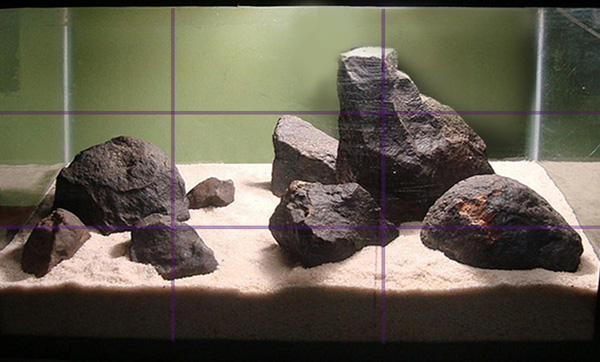Rule Of Thirds – Aquarium Aquascape
What Is It?
Rule of thirds is a rule or a method which is helpful when doing your element placement (ie. rock placement) for a natural aquarium aquascape.
The rule of thirds is used in the beginning stage of a hardscape design.
Hardscape
Elements – The Bones
Hardscape is your aquarium layout with rocks, gravel, tree roots and other decorative pieces.
The rule of thirds is meant to be used as a guide to ensure the elements, the bones, are placed in an aesthetically, pleasing manner. The rule or guide is made to control where the viewers’ eyes will travel, what they will focus on and what they will see. Photographers, landscape and aquascape artists use this rule when taking photos or designing landscaping and nature aquascaping pieces.
Breaking The Rules
You don’t have to follow the rule of thirds in your hardscape or natural aquarium. It may be easier to follow this rule when you are a beginner. This way you can get the feel of how to place elements aesthetically. You can still be successful and create a beautiful, stunning hardscape or natural aquarium when breaking the rules. I think of this type of aquascape art as “abstract scaping”.
Rule Of Thirds: Placing The Elements For Your Hardscape
Imagine that your natural aquarium is divided into nine equal parts by two equally spaced horizontal lines and two equally spaced vertical lines. The elements (rocks,etc) that you are using to scape should be placed along these lines or their intersections. The rule of thirds is used to create a more desirable and interesting design. Using the rules will allow the viewers’ eyes to flow through gracefully and enjoy the beauty within these intersections.
The very basic principle of the rule of thirds is the division of a photo into 9 equal parts. Confusing? Absolutely. Eventually it will fall into place.
You will want to think about where you would like your viewers’ eyes to be drawn first. This will be the focal point. From there, the eye will then explore your complimenting pieces in the rest of the scape. The rule of thirds helps you determine where you are placing the focal point and the secondary points in your design.

Explaining it further, start by imagining that there are four lines. Two lines are horizontal. Two lines are vertical. These lines are running through a square of white paper and it is divided into nine equal sections. Where the lines cross is called the golden focus point or the sweet spot for what you will be arranging on it. Photographers and artists utilize the rule of thirds in their work. Here is an example of a sweet spot or focal point in a photo. The basic principle of the rule of thirds, is the division of a photo into 9 equal parts. A grid.

Rule Of Thirds In Your Nature/Natural Aquarium
Here is the rule of thirds for a standard aquarium seen from the front. The solid red sweet spot is where you would place your largest and highest hardscape element like rock or a main piece of driftwood. This will be dependent upon what you have chosen. The red spot which appears to be faded is where your secondary hardscape feature would be placed. It is a complimentary piece to your focal point.
When transferring the same grid lines to the top of the aquarium, the rule of thirds is still in place. It indicates that the main element which is bigger and higher, will be placed near the back of the aquarium. The secondary faded red sweet spot tells that the complimenting element should be place closer to the front of the aquarium.

You can add other accent pieces remembering to keep them complimentary and harmonious together in style. There are many different combinations that you can create to achieve a beautiful result. For instance, filling 1/3 of the aquarium spaces with your main features and 2/3 of your space will be negative space or swimming space.
The rule of thirds can be confusing at first. When you have figured out the concept of it, you will be able to see how it is used in other aquariums. Test your understanding of the rule of thirds by looking at the hardscape and natural aquarium. Try to see how they have incorporated this rule into their design in the pictures below.


You don’t have to follow the rule of thirds in your hardscape or natural aquarium. It may be easier to follow this rule when you are a beginner so you can get the feel of how to place elements aesthetically. You can still be successful and create a beautiful, stunning hardscape or natural aquarium when breaking the rules. I think of this type of art as “abstract scaping”. Here are two examples of how the rule of thirds can be broken and still produce a beautiful scene that is pleasing to the eye and creates nice flow.
Creating Depth In Your Aquascape
There is usually not enough room, front to back, in an aquarium to create a real sense of perspective and depth. You will have to be creative and build an illusion of perception and depth by carefully positioning all the elements you have chosen in your scape. You can also do this by remembering the rule of thirds. Create more points of depth by beginning at the front of your tank where elements should be lowest and continue higher and higher in the following layers until reaching the back of your aquarium. You don’t need to place elements in a straight line from left to right or side to side, or it will look unnatural. The flow of the viewers’ eye will be off balance and will not know what to focus on. These are just guidelines to help you create a hardscape or aquascape with depth and dimension. In the photo below, it shows how rocks are placed in a layered look from side to side and front to back. Each rock is placed in a different plane and is not only creating depth but a naturalistic look. The rule of thirds was used to create the balance in this tank. Placing or layering rocks like this also keeps a fairly shallow and narrow foreground. The experienced aquascaper will uses the space outside the front of their tank for airiness (the space in between the elements and the aquarium glass). This also creates a sense of depth and will make a beautiful, natural transition between the foreground, midground and the background spaces. When creating the foreground, try to envision a riverbank. The edge of the water or shore has sand followed by smaller pebbles and as you get closer to the land, the rocks gradually get larger.

This article is meant to help give you an idea of what you can accomplish in an aquascape. The rule of thirds is a great way to create a focal point with a smooth flow through the placement of your elements. Remember, the rule of thirds is just a guideline and does not have to be applied.
Happy underwater gardening!
